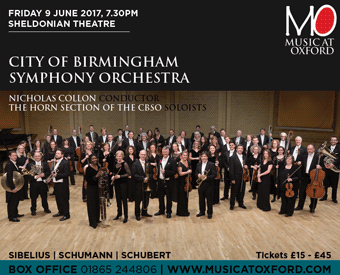The City of Birmingham Symphony Orchestra was at the Sheldonian on Friday evening, billed as being 'on tour' which is an odd term to use for a one-date foray outside Symphony Hall, Birmingham. No matter, especially since it brought with it more than 75 players who filled the orchestra space to the extent that had a piano been required, the pianist might have had to set his stool down in the corridor. The hall was pretty full and the programme exciting, comprising two little-played pieces and two gems of the repertoire. We began with Sibelius' King Christian II Suite, a compilation in four sections of incidental music for a history play of that name. This was new to me, and turned out to be a box of delights. The initial 'Nocturne' was tuneful from scraps of scales, and already the massed strings were producing a rich sound. Then came a sombre 'Elegy', followed by a 'Musette' (dance) that had clarinets and bassoons imitating the bagpipes in the format almost of a wind octet. The piece ended in a dark rush, and the whole had me scribbling a note to investigate what versions are out there on CD, and I can't have been alone in that.
Four French horns from the CBSO's brass section then appeared as soloists for Schumann's Konzertstück in F major for four horns and orchestra. I imagine one reason this is a relative stranger to the concert hall is that orchestras – for sure amateur bands – struggle to come up with four musicians able to play this demanding piece to the required standard. Here, our soloists were three men and Elspeth Dutch, elegant in a long, royal blue gown and silver diamante shoes. After two chords from the orchestra, the four solo horns entered fortissimo with the aggressive first subject, and here and throughout their tessitura is high, culminating in some demanding treble passages for the first horn in the recapitulation. The players were required to utter a hearty blare at times, often playing in sequence. I enjoyed the chorale-like subject in the middle section, played first by the fiddles and then by the horns themselves against a background of whirling arpeggios from the six cellos.
By now the audience was beginning to assess what kind of conductor was Nicholas Collon. Not unlike an elfin version of his mentor Sir Simon Rattle, he was a rather jerky if not marionette-like figure on the podium, employing lots of choppy arm movements, once or twice leaping in the air as though tugged from above. Lively in the first half of the concert, after the break I thought him curiously understated in Schubert's Symphony no. 8 "Unfinished", perhaps the most famous symphony of all after Beethoven's 5th. though the glorious ending to the 'allegro moderato' with a silky oboe, then strings and timpani in unison, was well handled; and so was the quasi-march in the 'andante con moto' – and I'd forgotten how closely Elgar in his Symphony No. 1 leaned on this section. The orchestra's principal clarinet and principal oboe sang out particularly effectively in their linked solos and duet.
Mr Collon came into his own with the concluding work, Sibelius' 7th Symphony, his symphonic swan-song and composed of one, continuous movement. The majestic trombone theme at which a solo flute had hinted early on boomed out round the Sheldonian from the three trombone and here we again revelled in the massed ranks of the orchestra in which the half-dozen basses and ditto cellos anchored the brass in a richness of sound. Every one of the seven symphonies sounds to me at the time of listening like Sibelius' supreme masterpiece, but maybe this one really is – unless that's the 5th or the 4th or the... Here the layers of sound built up by the composer, one of his characteristics, and involving elaboration rather than repetition were piled on in succession by the conductor like a pastry-cook constructing the sugary tiers of a wedding cake, and we rolled on to one of Sibelius' driving climaxes, in this case immediately preceded by a hushed moment from strings and timpani.




